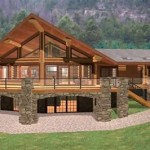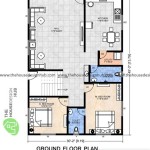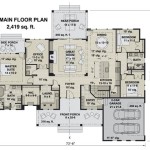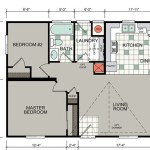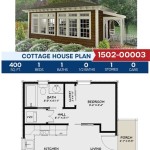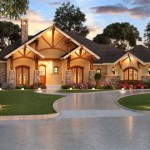Maximizing Space: Plans for a 600 Sq Ft Home
Designing a comfortable and functional home within a 600 square foot footprint presents a unique set of challenges and opportunities. Careful planning and innovative design solutions are crucial to creating a living space that feels both spacious and livable. This article will examine various planning strategies and design considerations for building a 600 sq ft home, focusing on optimizing space usage, natural light, and overall functionality.
The allure of a smaller home often lies in its simplicity, affordability, and reduced environmental impact. However, to achieve these benefits without sacrificing comfort, a deliberate and thoughtful approach to space planning is essential. This demands a critical assessment of lifestyle needs and a commitment to minimizing clutter and maximizing every available square inch.
Before diving into specific design elements, it's vital to consider the overall layout. A well-defined floor plan serves as the foundation for a successful small home design. Factors such as orientation to sunlight, privacy considerations, and access to utilities should all be taken into account during the initial planning phase.
Prioritizing Multifunctional Spaces
In a 600 sq ft home, dedicating separate rooms for specific purposes is often impractical. Instead, the emphasis should be on creating multifunctional spaces that can adapt to different needs throughout the day. This approach allows for greater flexibility and maximizes the utilization of the limited square footage.
One common strategy is to combine the living room, dining area, and kitchen into a single open-concept space. This creates a sense of spaciousness and allows for natural light to flow freely throughout the home. To define distinct zones within the open layout, consider using furniture arrangements, changes in flooring, or subtle color variations.
For example, a kitchen island can serve as a breakfast bar, food preparation area, and a visual divider between the kitchen and living room. A strategically placed sofa can delineate the living area from the dining space. By carefully selecting furniture and incorporating these spatial cues, it is possible to create a comfortable and functional living area that caters to a variety of needs.
Another area where multifunctional design is crucial is the bedroom. A murphy bed or a platform bed with built-in storage can free up valuable floor space during the day, allowing the bedroom to double as a home office or a guest room. Integrating a desk into the bedroom design provides a dedicated workspace without requiring a separate room.
Utilizing vertical space is also key when creating multifunctional areas. Installing shelving units that extend to the ceiling provides ample storage space without occupying valuable floor area. Consider using decorative baskets or boxes to contain items on shelves to keep the space organized and decluttered.
Beyond general living areas, consider the potential for adaptable outdoor spaces. A small patio or deck can significantly expand the usable living area, especially during warmer months. Outdoor furniture that can be easily stored or folded away can further enhance the flexibility of the outdoor space, allowing it to be used for dining, lounging, or entertaining.
Optimizing Storage Solutions
Effective storage solutions are paramount in a 600 sq ft home. Minimizing clutter is essential for maintaining a sense of order and spaciousness. Every available nook and cranny should be considered as potential storage space.
Built-in storage is often the most efficient way to maximize space. Custom-designed cabinets and shelves can be tailored to fit specific needs and optimize the use of awkward or underutilized areas. Consider incorporating storage into staircases, under windows, and along hallways.
In the kitchen, maximizing cabinet space is crucial. Utilize pull-out shelves, drawer organizers, and vertical dividers to make the most of the available storage. Consider installing a spice rack on the inside of a cabinet door to free up shelf space. Hanging pots and pans from a ceiling rack can also save cabinet space and add a touch of visual interest.
In the bathroom, wall-mounted cabinets and shelves can provide ample storage without taking up valuable floor space. A medicine cabinet with a mirrored door can serve a dual purpose, providing both storage and a reflective surface that can help to make the room feel larger.
Beyond built-in storage, consider using furniture with hidden storage compartments. Ottomans with lift-up lids, coffee tables with drawers, and benches with storage underneath can provide additional storage space without sacrificing functionality. Beds with drawers underneath can also offer significant storage capacity for bedding, clothing, or other items.
The use of vertical storage is also crucial for maximizing space in closets. Install multiple shelves and hanging rods to organize clothing and accessories efficiently. Consider using shelf dividers to keep stacks of clothing neat and organized. Utilize clear plastic bins to store seasonal items or items that are not used frequently.
Don't overlook the potential for using wall space for storage. Install hooks on walls to hang coats, hats, bags, or other items. Magnetic knife strips in the kitchen can free up counter space and keep knives within easy reach. Even small shelves above doorways can provide additional storage space for books, plants, or decorative items.
Enhancing Natural Light and Ventilation
Adequate natural light and ventilation are essential for creating a comfortable and healthy living environment in a small home. Maximizing natural light can make a space feel larger and more inviting, while proper ventilation can help to prevent mold and mildew growth and improve air quality.
Windows should be strategically placed to maximize sunlight exposure throughout the day. Consider using larger windows or installing skylights to bring in more natural light. Avoid using heavy window coverings that block out sunlight. Instead, opt for sheer curtains or blinds that allow light to filter through while still providing privacy.
The placement of windows should also take into account the orientation of the home. Southern-facing windows will provide the most sunlight exposure, while northern-facing windows will provide more consistent, diffused light. Eastern-facing windows can provide morning sunlight, while western-facing windows can provide afternoon sunlight. Consider these factors when deciding on the size and placement of windows in each room.
In addition to windows, consider using other strategies to enhance natural light. Light-colored walls and ceilings can reflect light and make a space feel brighter. Mirrors can also be used to reflect light and create the illusion of more space. Strategically placed mirrors can bounce light around the room and make it feel larger and more open.
Proper ventilation is also essential for maintaining a healthy living environment. Ensure that there is adequate ventilation in the kitchen and bathroom to remove moisture and odors. Install exhaust fans in these rooms to help remove excess moisture and prevent mold and mildew growth. Consider using cross-ventilation by opening windows on opposite sides of the home to allow for airflow.
Skylights can also provide natural ventilation in addition to natural light. Many skylights are equipped with operable vents that can be opened to allow for airflow. This can be particularly beneficial in rooms that do not have windows or that have limited ventilation.
Careful landscaping can also enhance natural light and ventilation. Avoid planting trees or shrubs that will block sunlight from entering the home. Consider planting trees or shrubs that will provide shade in the summer and allow sunlight to enter in the winter. This can help to regulate the temperature inside the home and reduce energy consumption.
By carefully planning the placement of windows, using light-colored finishes, incorporating mirrors, and ensuring adequate ventilation, it is possible to create a bright, airy, and comfortable living environment in a 600 sq ft home. These strategies can help to make the space feel larger and more inviting, while also improving the overall quality of life for the occupants.
In conclusion, designing a functional and comfortable 600 sq ft home requires careful planning, innovative design solutions, and a commitment to maximizing every available square inch. By prioritizing multifunctional spaces, optimizing storage solutions, and enhancing natural light and ventilation, it is possible to create a living space that feels both spacious and livable.

Пин на доске House Planning

Panther Plan 600 Sq Ft Cowboy Log Homes Small House Floor Plans One Bedroom Cabin

Tiny Home Plan Under 600 Square Feet 560019tcd Architectural Designs House Plans

600 Sq Ft House Plan Small Floor 1 Bed Bath 141 1140

20 New 600 Sq Ft House Plans 2 Bedroom Image Duplex Floor Square Smart

East Facing Vastu House Plan 600 Sqft Best 2bhk Design Houseplansdaily

House Map 600 Sq Ft Model Plan Floor Plans N

1 Bedroom Cabin Plan With 600 Sq Ft

1 Bed Home Plan Under 600 Square Feet 560020tcd Architectural Designs House Plans

600 Sq Ft House Plan Mohankumar Construction Best Company

